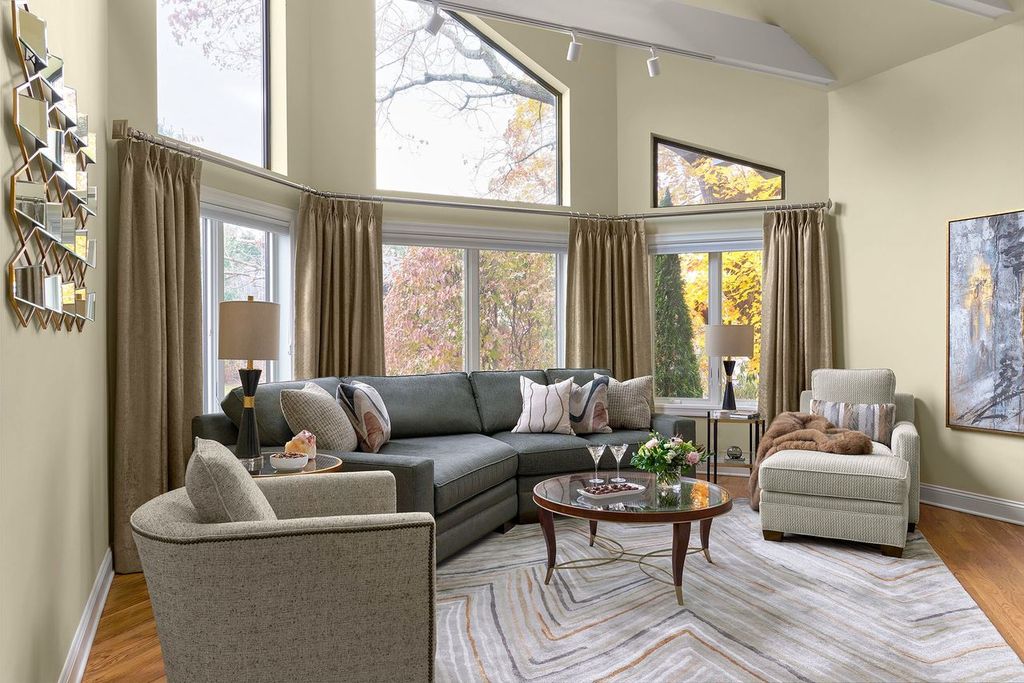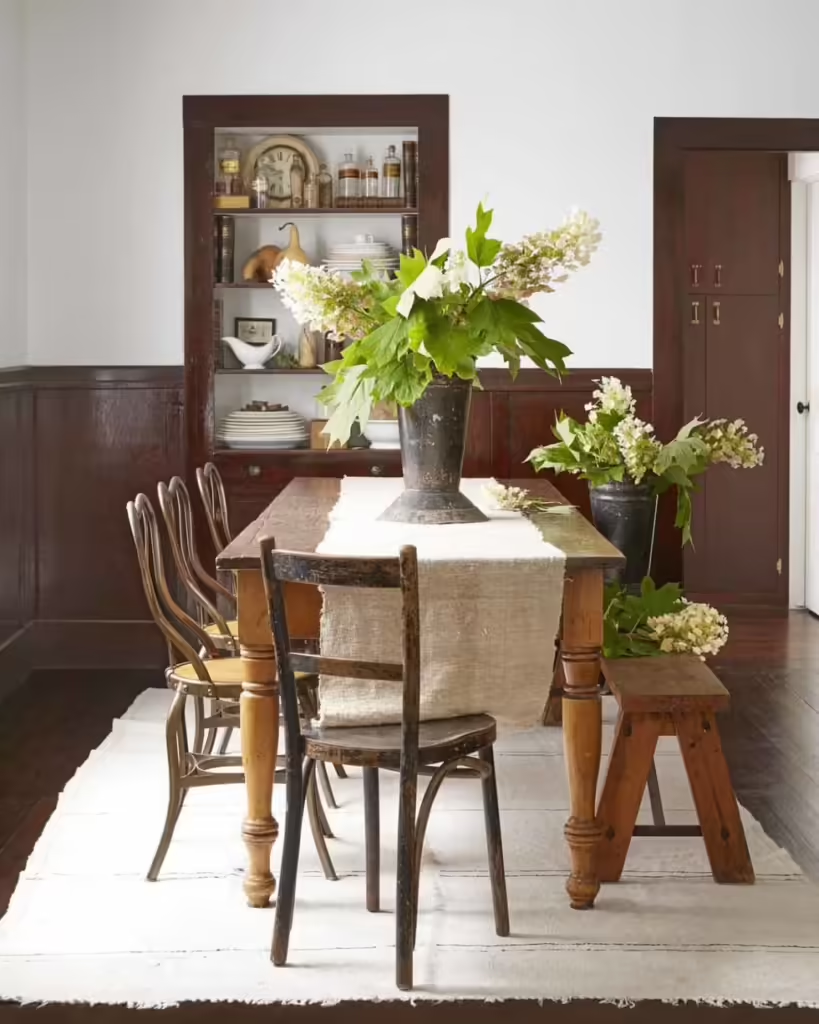Oh, the living room. Possibly a homeowner’s favorite room, especially when it’s newly furnished. It’s a room that brings people together, where conversations flow easily and laughs abound. It’s the perfect place for a family to gather or have friends over for a game night.
But what happens when you find yourself with an awkward living room layout? It could be that your room is too wide or too narrow. Perhaps an unexpected corner needs to be dealt with or a large wall of windows steals a lot of the wall space.
Regardless of the issue, it’s essential to get creative and think outside the box when trying to overcome tricky layouts. Let’s explore some clever interior design tips that will turn your awkward living room into a more usable space.
1. Bring in Room Dividers To Create Zones
One of the best interior design strategies for fixing an awkward living room layout is using dividers. By creating zones within a room, you separate areas meant for different purposes while still keeping them visually connected.
This is important because sometimes a large living room can feel overwhelming and too open. By breaking up the space with dividers, you create separate areas for entertaining or relaxing, depending on what fits your needs.
For example, dividers can separate the dining area from the TV area or even create an office space in your living room. This will allow you to keep the areas visually connected while still giving each space its own purpose.
Although room dividers are most commonly used in large living rooms, it’s still perfectly acceptable to use them in a small living room as well. In fact, they actually make your home feel more spacious if you’re using them correctly.
A divider could be anything from a portable screen to a bookshelf, which might give you extra storage space while still providing separation between areas. Taking advantage of vertical spaces can help maximize floor space for any awkward angles in your living area.
Here are some other ideas:
- For large living rooms: Consider dividing a space by carefully placing storage and display units, getting a custom-made floor-to-ceiling fireplace or adding an art installation.
- For small living rooms: Optimize small spaces by using dividers that don’t block off light, such as a minimalist screen made from natural materials. Another option is to incorporate house plants, which will also add to your living room’s overall aesthetic.
2. Address Specific Architectural Challenges
Do you have some odd angles or pre-existing architectural details to work around? Rather than trying to cover these parts of your room, use them to your advantage by highlighting their unique qualities. For example, let’s say you have big columns framing the room. Rather than hoping people’s eyes don’t stay on them too long, use them to put up open shelving, implement stylish storage or even use this section of the room as your designated bar cart corner.
Other seemingly difficult designs include super open layouts with no distinction between where the room starts or ends and split-level living rooms. Take what sticks out about these spaces — whether it’s a wide-open space, a natural break in the floor or a narrow living room — to play up the design and make the space as functional and gorgeous as possible.
 Refresh your living room with the right furniture and layout.
Refresh your living room with the right furniture and layout.3. Float Your Furniture
Floating your living room furniture means placing it away from the walls and into the center of the room. This is the best option for accommodating space with a large wall of windows and places with an irregularly-shaped interior.
However, you must choose the right multifunctional furniture and accessories to achieve a cozy atmosphere rather than a cramped room. Add interest by using pieces with a 360-degree appeal, whether through upholstery or by making them blend seamlessly together. For instance, a console table positioned behind a sectional sofa of the same height will create a visually-pleasing effect — and it also gives you more surface to decorate!
For large spaces, consider using a sectional that can fit multiple people. You can then combine it with extra seating areas, such as a pair of armchairs or another sofa that fits your style. Then, anchor the pieces with an area rug that defines the space and gives it a more finished look. This can also be a great way to add more visual interest and direct foot traffic in your awkward space, making it easier to navigate.
Additionally, arranging furniture this way creates a more intimate space than if the sofa and other seating were against the wall. This allows for personal conversations and can help you feel more connected to your guests.
4. Consider the Room’s Function
For all room sizes — but especially smaller areas — think about the room’s functionality and how you can use it. For example, if you have a focal point such as a large TV, fireplace or perhaps a beautiful coffee table, place your furniture toward it to bring attention to the piece and get the most use out of it. Or, if you love hosting or have a big family, ensuring there’s plenty of seating space while still maintaining a walking path is critical.
Where To Put a TV in an Awkward Room
It can be difficult when you have two focal points in a room, like a fireplace that isn’t centered on the wall and a TV a few feet away in any direction. Ideally, you’d place the TV over the fireplace to create a single focal point and position the furniture around it to create a conversation area. However, in some awkward living room layouts, this isn’t always possible.
In such situations, choose one element as your focal point and use interior design techniques to draw attention away from the other.
For example, try placing your main seating area around the TV and minimizing decoration near the fireplace. Or, do the opposite and have conversation-focused seating around the fireplace and paint the area around the TV in neutral colors.5. Use a Neutral Color Palette on the Walls
If you’re just starting out with a new space or are in the process of redecorating an awkward living room, it’s a good idea to use a neutral color palette on the walls.
That’s because neutral colors are known to make rooms feel more spacious and can help mask funky layouts by creating a cohesive and natural flow.
However, choosing a neutral palette doesn’t mean you have to compromise on your personal style — you can still show off your personality with accessories, artwork and furniture. That way, you draw attention to the things you love rather than the space itself.
You can add depth with dark neutrals or use large windows to your advantage by painting your walls a light neutral tone that reflects the natural light throughout your home.
Additionally, if you find your layout boring, add an accent wall to create a focal point.If your living room is too small, paint your whole house in neutrals to create a sense of spaciousness. The possibilities are endless, and you can always change things up as your tastes and needs evolve.
6. Embrace Different Shapes and Textures
It’s easy to get stuck when decorating if you’re thinking about ways to fix an awkward layout. But there are so many ways to play with different shapes and textures to create a cohesive yet interesting space, regardless of how odd the layout may be initially.
You might have harsh corners, freestanding columns or strange angles that leave you wondering how anyone thought that was a good idea. But with clever design and a sprinkle of creativity, you can turn those oddities into something that feels like a feature rather than a flaw.
Try painting those walls a contrasting color to the rest of the room. This is a great way to add a little flair to an otherwise dull area of your space and bring focus to those areas that might otherwise feel lost.
You can also try different wallpapers, textures and lighting options. This will help you to create the kind of ambiance that you want in your space, rather than just accepting it for what it is. For example, if there’s a very narrow space, why not make it a little darker to create a cozy reading nook? Or, if you have a really long wall that appears disproportionate, add some artwork, mirrors and pictures to decorate it and make it your personal style. And if you have a huge window with an unpleasant view, drapery will become your best ally!
How To Fill an Awkward Corner in Your Living Room
But it’s not just about home decor. It’s also about choosing the right shape of furniture to make your room look great. For example, you can soften corners and angles by using large, rounded pieces of furniture that create more of a curved line than the sharp one you were dealing with before.
Additionally, consider getting custom pieces made for your living room. This allows you to get the exact size and shape you want, and it’s the best way to make your space feel like it was made just for you.
7. Work With an Experienced Interior Designer
Awkward living room layouts can be tricky to overcome, and they’re often a cause of headaches for people trying to decorate their homes. If this is your case, you might want to work with an experienced interior designer.
When you book a complimentary consultation with Decorating Den Interiors, we’ll come to your house and help you figure out the best way to fix the layout of your living room.
We’ll also be able to recommend furniture pieces that will fit perfectly into your living space and budget so that you end up with a beautiful room that’s comfortable, visually appealing and practical.
Ready to get started? Enter your zip code to find the nearest interior decorator today.
The post Awkward living room layout ideas: How to overcome tricky spaces appeared first on Decorating Den Interiors.



